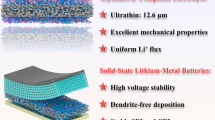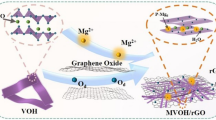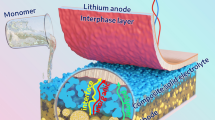Abstract
Novel manganese and boron containing nanomaterials have been investigated for applications in rechargeable lithium ion batteries (LIBs) in recent years owing since they are more environmentally-benign and more abundant in nature than the materials currently employed. In this study, one-dimensional (1D) Mn3B7O13OH nanorods and MnBO2OH nanorod bundles were controllably fabricated by using NH4HB4O7 and Mn(NO3)2 as reagents via a hydrothermal or solvothermal process, respectively, without any surfactants or templates at 220 °C. It is interesting to find that both materials are transformed into Mn2OBO3 nanorods/nanorod bundles by subsequent calcination. The formation processes of the above 1D borate containing products were investigated and the as-obtained four kinds of borates were studied as novel anode materials. It was found that the Mn2OBO3 nanorods displayed the best performance among the four borates, delivering an initial discharge capacitiy of 1,172 mAh·g−1 at 100 mA·g−1, and 724 mAh·g−1 could be retained after 120 cycles. A full battery composed of a Mn2OBO3 nanorod anode and a commercial LiFePO4 (or LiCoO2) cathode has also been assembled for the first time, which delivered an initial discharge capacity of 949 mAh·g−1 (779 mAh·g−1 for LiCoO2). The excellent cycle and rate performances of the products reveal their potential applications as anodes for LIBs.

Similar content being viewed by others
References
Reddy, M. V.; Subba Rao, G. V.; Chowdari, B. V. R. Metal oxides and oxysalts as anode materials for Li ion batteries. Chem. Rev. 2013, 113, 5364–5457.
Gong, Z. L.; Yang, Y. Recent advances in the research of polyanion-type cathode materials for Li-ion batteries. Energy Environ. Sci. 2011, 4, 3223–3242.
Rowsell, J. L. C.; Gaubicher, J.; Nazar, L. F. A new class of materials for lithium-ion batteries: Iron (III) borates. J. Power Sources 2001, 97, 254–257.
Rowsell, J. L. C.; Nazar, L. F. Synthesis, structure, and solid-state electrochemical properties of Cr3BO6: Anew chromium (III) borate with the norbergite structure. J. Mater. Chem. 2001, 11, 3228–3233.
Okada, S.; Tonuma, T.; Uebo, Y.; Yamaki, J. I. Anode properties of calcite-type MBO3 (M: V, Fe). J.Power Sources 2003, 119, 621–625.
Débart, A.; Revel, B.; Dupont, L.; Montagne, L.; Leriche, J. B.; Touboul, M.; Tarascon, J. M. Study of the reactivity mechanism of M3B2O6 (with M= Co, Ni, and Cu) toward lithium. Chem. Mater. 2003, 15, 3683–3691.
Wang, T. Y.; Peng, Z.; Wang, Y. H.; Tang, J.; Zheng, G.F. MnOnanoparticle@ mesoporouscarbon composites grown on conducting substrates featuring high-performance lithium-ion battery, supercapacitorand sensor. Sci. Rep. 2013, 3, 2693.
Chang, L.; Mai, L. Q.; Xu, X.; An, Q. Y.; Zhao, Y. L.; Wang, D. D.; Feng, X. Pore-controlled synthesis of Mn2O3 microspheres for ultralong-life lithium storage electrode. RSC Adv. 2013, 3, 1947–1952.
Li, L. H.; Nan, C. Y.; Lu, J.; Peng, Q.; Li, Y. D. α-MnO2 nanotubes: high surface area and enhanced lithium battery properties. Chem. Commun. 2012, 48, 6945–6947.
Du, J.; Gao, Y. Q.; Chai, L. L.; Zou, G. F.; Li, Y.; Qian, Y.T. Hausmannite Mn3O4nanorods: Synthesis, characterization and magnetic properties. Nanotech. 2006, 17, 4923.
Fernandes, J. C.; Sarrat, F. S.; Guimaraes, R. B.; Freitas, R. S.; Continentino, M. A.; Doriguetto, A. C.; Mascarenhas, Y. P.; Ellena, J.; Castellano, E. E.; Tholence, J. L. et al. Structure and magnetism of MnMgB2O5 and Mn2B2O5. Phys. Rev. B 2003, 67, 104413.
Continentino, M. A.; Pedreira, A. M.; Guimaraes, R. B.; Mir, M.; Fernandes, J. C.; Freitas, R. S.; Ghivelder, L. Specific heat and magnetization studies of Fe2OBO3, Mn2OBO3, and MgScOBO3. Phys. Rev. B 2001, 64, 014406.
Goff, R. J.; Williams, A. J.; Attfield, J. P. Spin, charge, and orbital order in Mn2OBO3. Phys. Rev. B, 2004, 70, 014426.
Li, S. L.; Xu, L. Q.; Zhai, Y. J.; Yu, H. X. Co-pyrolysis synthesis of Fe3BO6nanorods as high performance anodes for lithium-ion batteries. RSC Adv. 2014, 4, 8245–8249.
Norrestam, R.; Kritikos, M.; Sjödin, A. Manganese (II, III) oxyborate, Mn2OBO3: A distorted homometallicwarwickite-synthesis, crystal structure, band calculations, and magnetic susceptibility. J. Solid State Chem. 1995, 114, 311–316.
Rivas-Murias, B.; Rivadulla, F.; Sánchez-Andújar, M.; Castro-Couceiro, A.; Señarís-Rodríguez, M. A.; Rivas, J. Role of t(2g) versus e(g) interactions in the physical properties of A(2)OBO(3) (A = Mn, Fe). Chem. Mater. 2006, 18, 4547–4552.
Wang, Z. Y.; Luan, D. Y.; Boey, F. Y. C.; Lou, X. W. Fast formation of SnO2 nanoboxes with enhanced lithium storage capability. J. Am. Soc. 2011, 133, 4738–4741.
Guo, C. X.; Wang, M.; Chen, T.; Lou, X. W.; Li, C. M. A hierarchically nanostructured composite of MnO2/conjugated polymer/graphene for high-performance lithium ion batteries. Adv. Energy Mater. 2011, 1, 736–741.
Zhang, R. R.; He, Y. Y.; Li, A. H.; Xu, L. Q. Facile synthesis of one-dimensional Mn3O4/Zn2SnO4 hybrid composites and their high performance as anodes for LIBs. Nanoscale 2014, 6, 14221–14226.
Zhang, R. R.; He, Y. Y.; Xu, L. Q. Controllable synthesis of hierarchical ZnSn(OH)6 and Zn2SnO4 hollow nanoshperes and their applications as anodes for lithium ion batteries. J. Mater. Chem. A 2014, 2, 17979–17985.
Li, S. L.; Li, A. H.; Zhang, R. R.; He, Y. Y.; Zhai, Y. J.; Xu, L. Q. Hierarchical porous metal ferrite ball-in-ball hollow spheres: general synthesis, formation mechanism, and high performance as anode materials for Li-ion batteries. Nano Res. 2014, 7, 1116–1127.
Li, L.; Kovalchuk, A.; Tour, J. M. SnO2-reduced grphene oxide nanoribbons as anodes for lithium ion batteries with enhanced cycling stability. Nano Res. 2014, 7, 1319–1326.
Xia, H.; Xiong, W.; Lim, C. K.; Yao, Q. F.; Wang, Y. D.; Xie, J. P. Hierarchical TiO2-B nanowire@α-Fe2O3nanothorn core-branch arrays as superior electrodes for lithium-ion microbatteries. Nano Res. 2014. (DOI: 10.1007/s12274-014-0539-3)
Hu, L.; Zhong, H.; Zheng, X. R.; Huang, Y. M.; Zhang P.; Chen, Q. W. CoMn2O4 spinel hierarchical microspheres assembled with porous nanosheets as stable anodes for lithium-ion batteries. Sci. Rep. 2012, 2, 986.
Hassoun, J.; Bonaccorso, F.; Agostini, M.; Angelucci, M.; Betti, M. G.; Cingolani, R.; Gemmi, M.; Mariani, C.; Panero, S.; Pellegrini, V. et al. An advanced lithium-ion battery based on a graphene anode and a lithium iron phosphate cathode. Nano Lett. 2014, 14, 4901–4906.
Hassoun, J.; Lee, K. S.; Sun, K. Y.; Scrosati, B. An advanced lithium ion battery based on high performance electrode materials. J. Am. Chem. Soc. 2011, 133, 3139–3143.
Mai, Y. J.; Shi, S. J.; Zhang, D.; Lu, Y.; Gu, C. D.; Tu, J. P. NiO-graphene hybrid as an anode material for lithium ion batteries. J. Power Sources 2012, 204, 155–161.
Mai, Y. J.; Xia, X. H.; Chen, R.; Gu, C. D.; Wang, X. L.; Tu, J. P. Self-supported nickel-coated NiO arrays for lithiumion batteries with enhanced capacity and rate capability. Electrochim. Acta 2012, 67, 73–78.
Qiu, Y. C.; Xu, G. L.; Yan, K. Y.; Sun, H.; Xiao, J. W.; Yang, S. H.; Sun, S. G.; Jin, L. M.; Deng, H. Morphology-conserved transformation: synthesis of hierarchical mesoporous nanostructures of Mn2O3 and the nanostructural effects on Li-ion insertion/deinsertion properties. J. Mater. Chem. 2011, 21, 6346–6353.
Shenouda A. Y.; Liu, H. K. Studies on electrochemical behaviour of zinc-doped LiFePO4 for lithium battery positive electrode. J. Alloys Comp. 2009, 477, 498–503.
Deng, Y. F.; Li, Z. E.; Shi, Z. C.; Xu, H.; Peng, F.; Chen, G. H. Porous Mn2O3 microsphere as a superior anode material for lithium ion batteries. RSC Adv. 2012, 2, 4645–4647.
Lou, X. M.; Wu, X. Z.; Zhang, Y. X. A study about γ-MnOOH nanowires as anode materials for rechargeable Li-ion batteries. J. Alloys Comp. 2013, 550, 185–189.
Lou, X. M.; Wu, X. Z.; Zhang, Y. X. Goethite nanorods as anode electrode materials for rechargeable Li-ion batteries. Electrochem. Commun. 2009, 11, 1696–1699.
Kim, D. K.; Muralidharan, P.; Lee, H. W.; Ruffo, R.; Yang, Y.; Chan, C. K.; Peng, H. L.; Huggins, R. A.; Cui, Y. Spinel LiMn2O4 nanorods as lithium ion battery cathodes. Nano Lett. 2008, 8, 3948–3952.
Jiang, J.; Li, Y. Y.; Liu, J. P.; Huang, X. T. Building one-dimensional oxide nanostructure arrays on conductive metal substrates for lithium-ion battery anodes. Nanoscale 2011, 3, 45–58.
Jiang, J.; Li, Y. Y.; Liu, J. P.; Huang, X. T.; Yuan, C. Z.; Lou, X. W. Recent advances in metal oxide-based electrode architecture design for electrochemical energy storage. Adv. Mater. 2012, 24, 5166–5180.
Jiang, J.; Luo, J. S.; Zhu, J. H.; Huang, X. T.; Liu, J. P.; Yu, T. Diffusion-controlled evolution of core-shell nanowire arrays into integrated hybrid nanotube arrays for Li-ion batteries. Nanoscale 2013, 5, 8105–8113.
Zhang, X.; Qian, Y. T.; Zhu Y. C.; Tang, K. B. Synthesis of Mn2O3 nanomaterials with controllable porosity and thickness for enhanced lithium-ion batteries performance. Nanoscale 2014, 6, 1725–1731.
Yoshio, M.; Tsumura, T.; Dimov, N. Electrochemical behaviors of silicon based anode material. J. Power Sources 2005, 146, 10–14.
Author information
Authors and Affiliations
Corresponding author
Electronic supplementary material
Rights and permissions
About this article
Cite this article
Li, A., Xu, L., Li, S. et al. One-dimensional manganese borate hydroxide nanorods and the corresponding manganese oxyborate nanorods as promising anodes for lithium ion batteries. Nano Res. 8, 554–565 (2015). https://doi.org/10.1007/s12274-014-0669-7
Received:
Revised:
Accepted:
Published:
Issue Date:
DOI: https://doi.org/10.1007/s12274-014-0669-7




